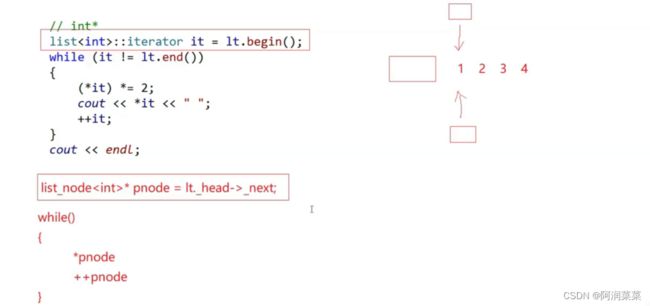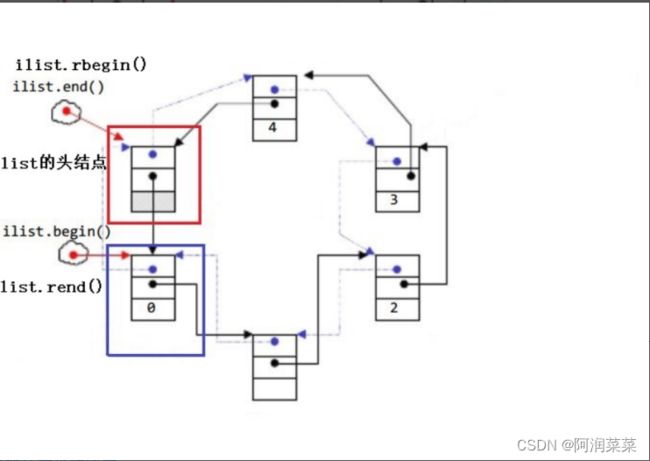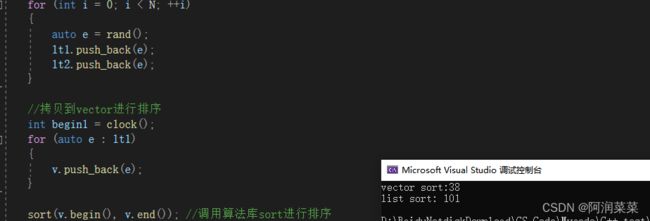【STL】list剖析及模拟实现
✍作者:阿润菜菜
专栏:C++
初识list
1. list基本概况
- list是可以在常数范围内在任意位置进行插入和删除的序列式容器,并且该容器可以前后双向迭代。
- list的底层是双向链表结构,双向链表中每个元素存储在互不相关的独立节点中,在节点中通过指针指向其前一个元素和后一个元素。
- list与forward_list非常相似:最主要的不同在于forward_list是单链表,只能朝前迭代,已让其更简单高效。
- 与其他的序列式容器相比(array,vector,deque),list通常在任意位置进行插入、移除元素的执行效率更好。
- 与其他序列式容器相比,list和forward_list最大的缺陷是不支持任意位置的随机访问,比如:要访问list的第6个元素,必须从已知的位置(比如头部或者尾部)迭代到该位置,在这段位置上迭代需要线性的时间开销;list还需要一些额外的空间,以保存每个节点的相关联信息(对于存储类型较小元素的大list来说这可能是一个重要的因素.
- 与string和vector不同,list的遍历需要通过迭代器来实现,list的迭代器也不再是原生指针,而是模拟原生指针行为的一层封装。
- 对于范围for的实现,本质就是通过迭代器,范围for可以遍历容器的迭代器,对迭代器进行解引用,然后依次拷贝给元素e,所以C++11的范围for没有什么新花样,本质上使用的还是迭代器实现的。
下面我们看看list的使用:
2.list常见的重要接口
先贴上官方文档:list文档介绍
一、 对于list的构造我们有四种构造方式:
构造空的list、构造含有n个值为val的元素初始化list、拷贝构造、区间(first,last)元素构造list。
void TestList1()
{
list<int> l1; // 构造空的l1
list<int> l2(4, 100); // l2中放4个值为100的元素
list<int> l3(l2.begin(), l2.end()); // 用l2的[begin(), end())左闭右开的区间构造l3
list<int> l4(l3); // 用l3拷贝构造l4
// 以数组为迭代器区间构造l5
int array[] = { 16,2,77,29 };
list<int> l5(array, array + sizeof(array) / sizeof(int));
// 列表格式初始化C++11
list<int> l6{ 1,2,3,4,5 };
// 用迭代器方式打印l5中的元素
list<int>::iterator it = l5.begin();
while (it != l5.end())
{
cout << *it << " ";
++it;
}
cout << endl;
// C++11范围for的方式遍历
for (auto& e : l5)
cout << e << " ";
cout << endl;
}
二、ist迭代器的使用:
1.在使用上时可以将迭代器理解成一个指针,该指针指向list中的某个节点。同时提供了正向迭代器和反向迭代器。
2… 注意:begin与end为正向迭代器,对迭代器执行++操作,迭代器向后移动
rbegin(end)与rend(begin)为反向迭代器,对迭代器执行++操作,迭代器向前移动
// 注意:遍历链表只能用迭代器和范围for
void PrintList(const list<int>& l)
{
// 注意这里调用的是list的 begin() const,返回list的const_iterator对象
for (list<int>::const_iterator it = l.begin(); it != l.end(); ++it)
{
cout << *it << " ";
// *it = 10; 编译不通过
}
cout << endl;
}
void TestList2()
{
int array[] = { 1, 2, 3, 4, 5, 6, 7, 8, 9, 0 };
list<int> l(array, array + sizeof(array) / sizeof(array[0]));
// 使用正向迭代器正向list中的元素
// list::iterator it = l.begin(); // C++98中语法
auto it = l.begin(); // C++11之后推荐写法
while (it != l.end())
{
cout << *it << " ";
++it;
}
cout << endl;
// 使用反向迭代器逆向打印list中的元素
// list::reverse_iterator rit = l.rbegin();
auto rit = l.rbegin();
while (rit != l.rend())
{
cout << *rit << " ";
++rit;
}
cout << endl;
}
三、list的空间大小

四、list元素获取

五、list的元素操作
1.对于list来说,insert不会导致迭代器失效,vector存在迭代器失效是因为在扩容时reserve采取异地扩容的方式,这就导致原有迭代器指向了已经被释放的空间。
但list并不存在扩容这样的操作,list直接按需申请空间,你要插入多少个节点,那我就申请多少个节点,然后将所有的节点链接到哨兵节点前面就好了,所以insert之后迭代器依旧可以继续使用,因为他对应的节点空间不会被销毁,依旧好好的存在着。
2.对于list的erase来说就不一样了,erase会释放迭代器对应节点的空间,自然erase之后迭代器就会失效,如果想要继续使用迭代器,则可以利用erase的返回值来更新迭代器,erase会返回被删除节点的下一个节点的迭代器,我们可以用erase的返回值来更新迭代器
// list插入和删除
// push_back/pop_back/push_front/pop_front
void TestList3()
{
int array[] = { 1, 2, 3 };
list<int> L(array, array + sizeof(array) / sizeof(array[0]));
// 在list的尾部插入4,头部插入0
L.push_back(4);
L.push_front(0);
PrintList(L);
// 删除list尾部节点和头部节点
L.pop_back();
L.pop_front();
PrintList(L);
}
// insert /erase
void TestList4()
{
int array1[] = { 1, 2, 3 };
list<int> L(array1, array1 + sizeof(array1) / sizeof(array1[0]));
// 获取链表中第二个节点
auto pos = ++L.begin();
cout << *pos << endl;
// 在pos前插入值为4的元素
L.insert(pos, 4);
PrintList(L);
// 在pos前插入5个值为5的元素
L.insert(pos, 5, 5);
PrintList(L);
// 在pos前插入[v.begin(), v.end)区间中的元素
vector<int> v{ 7, 8, 9 };
L.insert(pos, v.begin(), v.end());
PrintList(L);
// 删除pos位置上的元素
L.erase(pos);
PrintList(L);
// 删除list中[begin, end)区间中的元素,即删除list中的所有元素
L.erase(L.begin(), L.end());
PrintList(L);
}
其实list还提供了一个sort函数,但因为效率很低,我们基本上不会用,对比同样的算法库函数sort,如果你要排序list,倒不如先将list的数据拷贝到vector进行排序,等排完序再将数据拷贝回list里面去,就算这样的排序的性能都是要比直接用list进行排序的性能要高不少 ---- 一定要release下进行对比,能差一倍!
测试代码:
#include
#include算法库的sort底层用的是快速排序,为了key值选的合适,快排会进行三数取中,所以会进行迭代器的作差,而list的双向迭代器肯定不支持做差,所以调用算法库的sort就会报错。
如果想要排序链表,那就只能调用list类的成员函数sort来进行排序,list的sort底层用的是归并排序。
这里就要引出迭代器从功能上来说,可以分为三类:只能++的单向迭代器(单链表、哈希表),既能++也能 - - 的双向迭代器(list带头双向循环链表),既能++也能 - - 还能±某个具体的数的随机迭代器(string、vector)

resize用于调整链表的空间,如果是调整大一些,那就是一个一个的申请节点,尾插到链表上面去。如果是调整小一些,那也需要一个个的释放节点,相当于尾删节点。
// insert /erase
void TestList4()
{
int array1[] = { 1, 2, 3 };
list<int> L(array1, array1 + sizeof(array1) / sizeof(array1[0]));
// 获取链表中第二个节点
auto pos = ++L.begin();
cout << *pos << endl;
// 在pos前插入值为4的元素
L.insert(pos, 4);
PrintList(L);
// 在pos前插入5个值为5的元素
L.insert(pos, 5, 5);
PrintList(L);
// 在pos前插入[v.begin(), v.end)区间中的元素
vector<int> v{ 7, 8, 9 };
L.insert(pos, v.begin(), v.end());
PrintList(L);
// 删除pos位置上的元素
L.erase(pos);
PrintList(L);
// 删除list中[begin, end)区间中的元素,即删除list中的所有元素
L.erase(L.begin(), L.end());
PrintList(L);
}
// resize/swap/clear
void TestList5()
{
// 用数组来构造list
int array1[] = { 1, 2, 3 };
list<int> l1(array1, array1 + sizeof(array1) / sizeof(array1[0]));
PrintList(l1);
// 交换l1和l2中的元素
list<int> l2;
l1.swap(l2);
PrintList(l1);
PrintList(l2);
// 将l2中的元素清空
l2.clear();
cout << l2.size() << endl;
}
list的模拟实现
list的迭代器 — 精华部分
迭代器的价值是什么:
a.迭代器对底层的实现进行封装,不暴露底层实现的细节。
b.提供统一的访问方式,降低使用者的使用成本。
- 实现list的迭代器,最底层其实就是一个链表节点结构体的指针,我们知道 迭代器: 要么就是原生指针,要么就是自定义类型对原生指针的封装,本质都是模拟指针的行为! 所以对list要实现迭代器的功能,我们对这个指针进行了封装,所以list的迭代器就是用一个自定义类型来封装 node* 。
- 我们知道对于模板实例化,加上模板参数才是类型,否则就是类名。
在实现const版本迭代器时最容易想到的一种方式就是重新构建一个类,类里面原有成员函数都不变,仅仅是将类名做出修改,然后我们把解引用函数的返回值修改成常引用,在使用const_iterator迭代器类型的时候,如果你解引用迭代器则直接调用__list_const_iterator类里面的返回常引用的重载函数。 - == 这样显然是代码冗余的,大佬是怎么做的?其实是通过增加模板参数,在传参数时,根据参数类型的不同实例化出不同的类。==
例如用const_iterator时,就是用第二个模板参数为const T&的类模板,等T类型确定时,就会实例化出具体的类,当用iterator时,我们就用第二个模板参数为T&的类模板,等T类型确定时,又会实例化出另一个不同的类。 - 当list存的是结构体类型Pos时,直接打印解引用迭代器后的值就会出现问题,因为解引用迭代器后拿到的是Pos类的对象,所以如果想要打印对象的值,我们可以重载Pos类的流插入运算符来实现,如果Pos类的成员变量是私有的,我们也可以用友元函数来解决。
- 如果是普通指针我们一般就用解引用,如果是结构指针,我们喜欢用→的访问方式。当迭代器指向的数据是一个结构体对象时,我们更偏向于用→来访问,当迭代器指向的数据是单个数据时,我们更偏向于用*来访问。
- 所以下面→解引用的使用方式更舒服一些,因为迭代器it所指向的内容是Pos结构体的对象。但it不是一个结构体指针,不能用→这样的访问方式,这该如何解决呢?因为it是一个对象,我们可以利用运算符重载来解决。
- 这里
template三个模板参数分别是提供 T& 、const T& 和提供解引用访问(→)
//迭代器 --- 自定义类型封装node*
//分类:1.原生指针 2.用自定义类型对原生指针的封装,模拟指针的行为
//即->迭代器: 要么就是原生指针,要么就是自定义类型对原生指针的封装,本质都是模拟指针的行为!
template<class T, class Ref, class Ptr> //通过增加模板参数,提供多版本迭代器
struct _list_iterator
{
typedef list_node<T> node; //加上模板参数才是类型,否则只是类名
typedef _list_iterator<T, Ref, Ptr> self; //方便后面返回值,做参数
node* _node; //指针
_list_iterator(node* n) // 提供构造函数,遍历使用
:_node(n)
{}
Ref operator* () //提供const版本迭代器
{
return _node->_data;
}
//const 迭代器和普通迭代器的区别是什么? 一个内容可修改 ,一个内容不可被修改
Ptr operator->() //->重载
{
return &_node->_data; //引用返回减少拷贝
}
//++返回什么? 返回迭代器呀!
self& operator++() //遍历 前置++
{
_node = _node->_next;
return *this;
}
self& operator++(int) //后置++
{
self tmp(*this); //拷贝构造一下
_node = _node->_next;
return tmp;
}
self& operator--()
{
_node = _node->_prev;
return *this;
}
self& operator--(int)
{
self tmp(*this);
_node = _node->_prev;
return tmp;
}
bool operator!=(const self& s)
{
return _node != s._node;
}
bool operator ==(const self& s)
{
return _node == s._node;
}
};
- 那这个迭代器是浅拷贝可以吗? 可以呀,因为这个是node的指针,浅拷贝后指针指向同一个node是可以的。那为什么没有报错呢? 因为我们没有提供析构函数。 而且不释放当然是正确的,因为这里结点是属于链表的,释放结点的工作应该交给链表类而不是迭代器类。
所以当内置类型涉及资源申请时,也并不一定就要写析构函数,还需要视情况而定。迭代器只是一个工具而已,释放也得由开辟空间的对象(list)来释放
10.对于迭代器的封装: 底层物理上都是指向这个对象的4个字节的指针。但语法的千差万别,主要还是运算符重载!

重点的两个接口 — insert 和 erase
- 实现insert时可以看到所传参数是迭代器,实际就是链表结点的地址,也是一个结构体指针,只不过我们对这个结构体指针进行了封装,这个迭代器就变成了一个对象,在实现上和数据结构初阶实现的带头双向循环链表没什么区别,仅仅是多了一个类的封装。
- 那insert这里迭代器会不会失效? 不会,pos指向节点没有发生地址改变
- erase这里迭代器失效吗 肯定失效。因为迭代器指向被干掉了。 所以我们可以加个断言啊---- 谁不可以erase? — 哨兵位头节点
- 迭代器失效即迭代器所指向的节点的无效,即该节点被删除了。因为list的底层结构为带头结点的双向循环链表,因此在list中进行插入时是不会导致list的迭代器失效的,只有在删除时才会失效,并且失效的只是指向被删除节点的迭代器,其他迭代器不会受到影响。
- 实现erase时返回删除位置的下一个位置的迭代器,以便于使用者更新erase之后的迭代器,防止产生迭代器失效问题。
//insert函数 pos前插入x
//insert这里迭代器会不会失效? 不会,pos指向节点不会发生地址改变
void insert(iterator pos, const T& x)
{
node* cur = pos._node; //指针
node* prev = cur->_prev;
node* new_node = new node(x); //堆区申请
prev->_next = new_node;
new_node->_prev = prev;
new_node->_next = cur;
cur->_prev = new_node;
}
//erase函数 删除pos位置
void erase(iterator pos)
{
assert(pos != end()); //防止删除哨兵节点
node* next = pos._node->_next;
node* prev = pos._node->_prev;
prev->_next = next;
next->_prev = prev;
delete pos._node;
}
小问题
//赋值重载
list<T>& operator=(const list<T> l)
{
swap(l);
return *this;
}
- list的反向迭代器:通过前面例子知道,反向迭代器的++就是正向迭代器的–,反向迭代器的–就是正向迭代器的++,因此反向迭代器的实现可以借助正向迭代器,即:反向迭代器内部可以包含一个正向迭代器,对正向迭代器的接口进行包装即可。
//反向迭代器
// 适配器 -- 复用
template<class Iterator, class Ref, class Ptr>
struct Reverse_iterator
{
Iterator _it;
typedef Reverse_iterator<Iterator, Ref, Ptr> Self;
Reverse_iterator(Iterator it)
:_it(it)
{}
Ref operator*()
{
Iterator tmp = _it;
return *(--tmp);
}
Ptr operator->()
{
return &(operator*());
}
Self& operator++()
{
--_it;
return *this;
}
Self& operator--()
{
++_it;
return *this;
}
bool operator!=(const Self& s)
{
return _it != s._it;
}
};
- 显示报错报错 没有合适的默认构造函数怎么办? 提供缺省----缺省函数为什么用 T() :调用其默认构造
- 这个是很多人的疑惑:const对象在定义时有没有const属性? 答案是没有的!否则我们如何对数据进行初始化?所以这里是编译器的特殊处理罢了,站在语法的角度,就初始化后在赋予const属性
list模拟实现源码参考
list与vector的对比
vector
优点:
a.支持下标的随机访问
b.尾插尾删效率高
c.CPU高速缓存命中率高(局部性原理)
缺点:
a.前面部分插入删除数据效率低(插入和删除需要挪动数据,尤其是数据量大时效率较低)
b.扩容有消耗,还存在一定空间浪费(2倍扩容是比较合适的,开大了浪费空间,开小了需要频繁扩容)
list
优点:
a.按需申请释放空间,无需扩容
b.任意位置插入删除的时间复杂度是O(1),不考虑find查找位置,只是单纯erase和insert。
缺点:
a.不支持下标的随机访问
b.CPU高速缓存命中率低(局部性原理)
- vector的insert和erase之后迭代器都会失效,list在insert之后迭代器不会失效,erase之后迭代器会失效
- 在需要高效存储,支持随机访问,不关心插入删除效率,我们倾向于使用vector
- 大量插入和删除操作,不关心随机访问的情况,我们倾向于使用list,而且现实中项目中list用的蛮多的
少熬夜,早点休息!



